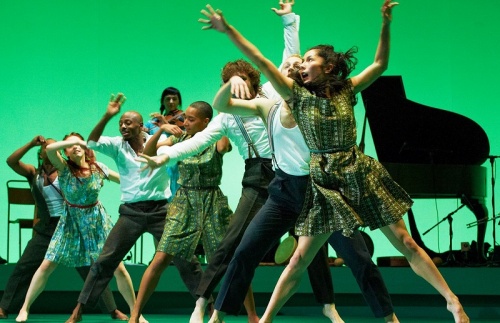RIAN
St James Theatre 2, Wellington
12/03/2014 - 15/03/2014
New Zealand Festival of the Arts 2014
Production Details
FABULOUS BEAST DANCE THEATRE
Described by The Times as “one of the most daring and highly original dance theatre companies in the world,” Fabulous Beast is an international ensemble based in County Longford, Ireland, led by artistic director Michael Keegan-Dolan.
The company is best known for several groundbreaking and controversial productions, delivered in a unique style blending narrative and physical theatre, dance, speech and song. These include three Olivier Award-nominated productions: Giselle (2003), The Bull (2005) and The Rite of Spring (2009) – a co-production with English National Opera – as well as James, Son of James (2007).
Rian (2011), a co-production with Sadler’s Wells, London was nominated for an Irish Times Theatre Award. In 2012 and 2013 Rian toured the world, and was performed in UK, Germany, Spain, USA, Australia, France, Hong Kong, Austria, Singapore and Ireland. 2013’s Stravinksy Double Bill is a reimagining of 2009’s The Rite of Spring and a brand new
Petrushka. It received its premier in Sadler’s Wells, London in April 2013 before visiting Movimentos, Germany; Galway Arts Festival; Brisbane Festival and Melbourne Festival in Australia.
Fabulous Beast Dance Theatre is supported by Arts Council Ireland. International Touring is supported by
Culture Ireland. Co-produced by Fabulous Beast Dance Theatre and Sadler’s Wells, London.
Cast: Saju Hari, Zen Jefferson, Anna Kaszuba, Louise Mochia, Eithne Ní Chatháin, Cormac Ó Beaglaoich, Emmanuel Obeya, Maitiú Ó Casaide, Liam Ó Maonlaí, Peter O’Toole,
Keir Patrick, Ino Riga, Lousie Tanoto
Rehearsal Director Rachel Poirier
Lighting designer Adam Silverman
Set designer Sabine Dargent
Costume designer Doey Lüthi
Sound designer Denis Clohessy
Assistant music director Philip Feeney
Contemporary dance ,
1hr 25 mins
An impeccable evening of joyous expression
Review by Lyne Pringle 13th Mar 2014
There is spontaneous applause as the red velvet curtain of the opulent St James Theatre lifts to reveal a curved green space with dancer and musicians seated on a raised platform – the only adornment is a lamp atop a harpsichord – it is a breath-taking sight that is elegantly simple. The dance and music performance Rian (trace or mark in Gaeilge) spills forth from this image – an impeccable evening of joyous expression. The spontaneous, elated standing ovation at the end is a testament to the transformative power of the event and the generosity of the performers. It is a pleasure, in this era of apocalyptic dark-torrid-angst ridden work, to be offered another solution to the human condition: to celebrate a sense of community and simply dance to the music.
The beating heart of the performance is musical director, singer and musician Liam ó maonlaí, his music gives the work structure. He states “We need to channel land, wind, fire and water; Heaven and Earth. It is important to listen again and again and again and again and again and sing”. The direction and choreography by Michael Keegan-Dolan supports maonlaí’s commitment to the ancient Irish Sean-nós form. Whilst this is primarily an expression for solo voice it also has a dance custom that is characterised by low to the ground footwork, improvised steps, free movement of the arms, and an emphasis upon a battering step which sounds out the accented beat of the music. By its nature, it follows the music closely.
Keegan-Dolan has taken this provocation to create, with his distinctive dancers a choreographic language that is gentle and understated. Phrases spring from the heart centre with impetus generated by rotation of the thorax leading to looping enveloping arms in gathering gestures that often reach skyward. The legs movements are grounded and simple, the stance often wide. There is a lot of repetition, sequences build slowly often from a solo dancer. At no point does the choreography overpower the music. There is a good deal of space left to sit back, relax and be lulled into looking and listening. One could argue that the work requires more drive and complexity, but there is great charm in the tenderness and delicacy of the choreographic choices.
There are surprising moments; an evocation of the Indian god Shiva early on; a sudden stop; a distinctive stage manager; the odd gag between dancers and musicians; a line-up of dancers and musicians across the front of the stage and spooky shadows; musicians dancing and dancers singing, a Moorish tinge to the Irish sound; and a quick trip to West Africa when the dancers and musicians immerse themselves in the distinctive rhythm derived from the camel.
The dancers from all over the world are memorable in their individuality and each has a moment to shine as the Irish diaspora morphs and changes to envelope them. They conjure and draw the audience in with a subtle flick of the wrist. The sound of a foot tapping floats up from the auditorium and it is difficult to stay still in one’s seat as the kinaesthetic tendrils from the stage make the dance accessible to all. At one point they are like nature sprites on hot coals with the soundscape of bodhrán, concertina, Irish pipes, piano, harp, fiddle and mandolin perfectly delivered by the stunning band of musicians.
This is what two people said as they left the theatre “They’ve got some of my dance moves.” “Yeah! I just wanted to up there and do some moves.”
As stated in their publicity “Rian taps into healthy life-enhancing traditions with influences from faraway places to evoke a timeless vision of the real indescribable nature of things”
And they do. Go see it. The world needs this kind of dance at this time.
Copyright © in the review belongs to the reviewer






Comments